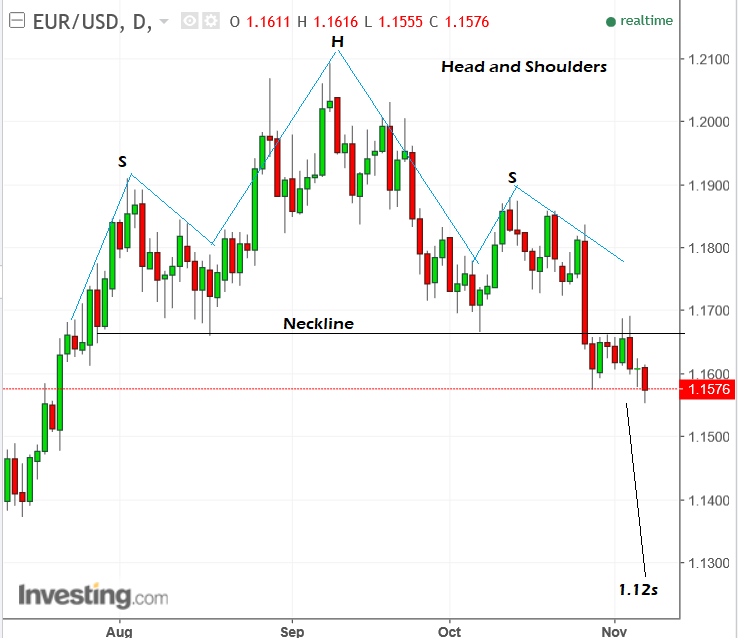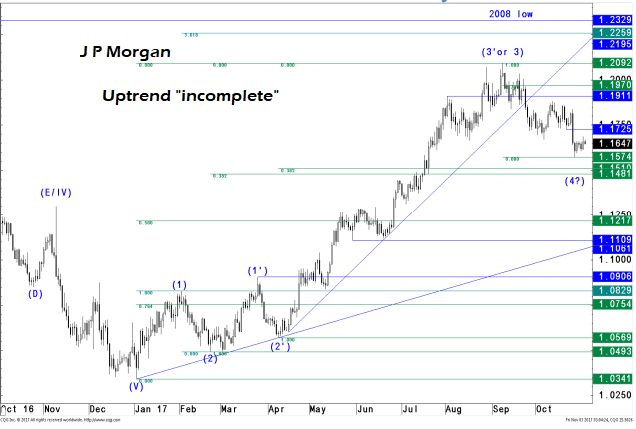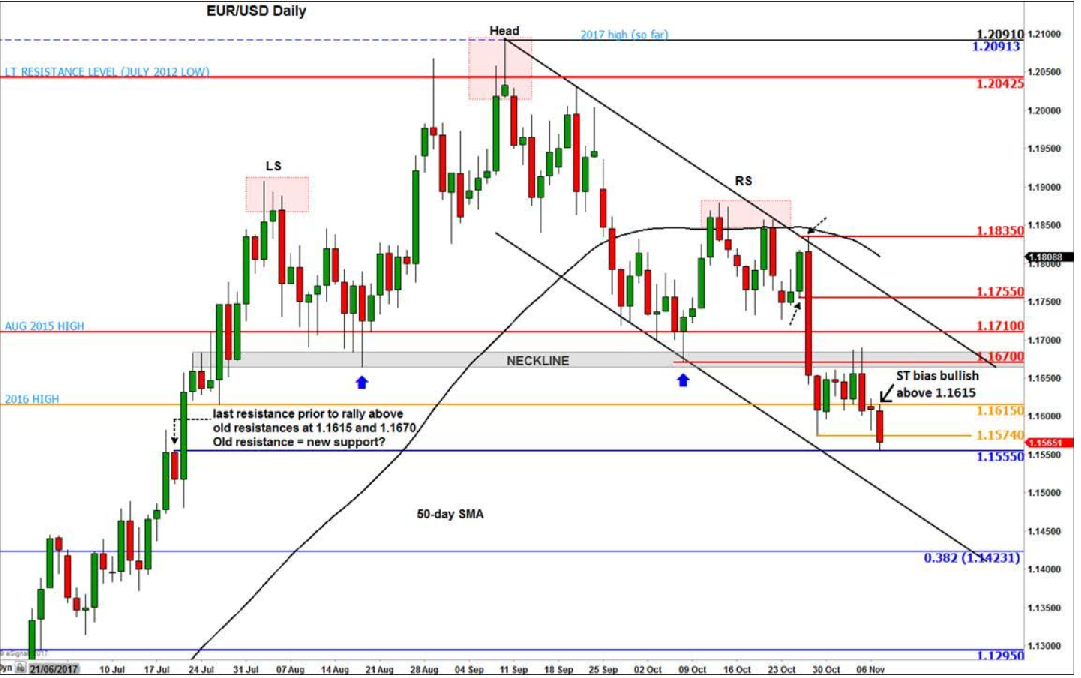Euro-to-Dollar Outlook: Disputing the Bearish Head & Shoulders View

A good portion of the technical analyst community are forecasting the EUR/USD lower - here we hear from the contrarians who are more bullish on the Euro's prospects.
Techncial analysis is the method of using price action and price charts to forecast financial assets and differs from fundamental analysis which uses economic data for forecasting.
In this article, we are going to focus on the technical analysis of the EUR/USD currency pair and look at some contrarian views regarding the pair - contrarian meaning against the general consensus.
Most technical analysts think that EUR/USD is going lower after forming a bearish topping pattern and they see the exchange rate as probably already on its way down to a target which is estimated to be as low as the mid 1.12s (current market level 1.1575).
The topping pattern is familiar to those with any knowledge of technical analysis, but for those who don't, it is called a Head and Shoulders (H&S) (see below).

The H&S is made up of three consecutive peaks and occurs at the end of uptrends; it is a sign the trend is changing and is about to break sharply lower.
The middle peak is always higher and represents the 'head' whilst the two lower peaks either side are known as the 'shoulders'.
Confirmation that prices will go lower is supplied by a break below the pattern's neckline, which is the line drawn joining the lows of the two intervening troughs (between the three peaks).
Following a break below the neckline the exchange rate is expected to decline substantially, that is to say, by a distance equal to the height of the H&S at its tallest extrapolated from the neckline lower.
On EUR/USD a clear H&S has formed and the exchange rate has actually now also broken below the neckline too, confirming downside to the official target in the 1.12s.
The current consensus view is that the exchange rate has completed this topping pattern, broken below its neckline and is heading lower.
The view is exemplified by Commerzbank Analyst Karen Jones, who writes that:
"EUR/USD is under pressure - a head and shoulders top has been followed by a bear flag pattern – this is very negative price action," she says, adding:
"The measurement down from the head and shoulders top pattern 1.2092-1.1662, is 1.1232. Given the close proximity of the 200-day ma at 1.1276 we will make this our downside target."
Our own analysis echoes that of Commerzbank's Jones:
"Our observations confirm EUR/USD has formed a compelling topping reversal pattern called a head and shoulders (H&S) top, a development that advocates for further potential downside over coming days."
We go on to stipulate targets similar to those of Karen Jones:
"Normally the fall from an H&S is equal to the height of the pattern from the peak of the head to the neckline extrapolated from the neckline lower.
"This gives an eventual downside target of 1.1255, however, in this case we think the eventual target will probably actually be slightly higher at 1.1275, just above the level of the 200-day moving average (MA)."
The Opposite View
Not all analysts are sure about the bearish H&S hypothesis, with a few exceptions more optimistic on the Euro's prospects.
One analyst who is more skeptical about this outright bearish view of EUR/USD is JP Morgan FX Analyst Thomas Anthonj.
His view is more nuanced and even possibly bullish as he argues the uptrend prior to the formation of the EUR/USD looks 'incomplete'.
"The 2017 Euro up-trend looks incomplete, but remains at risk of retracing back to 1.1510/1.1481," says Anthonj.
The analyst, nevertheless, sees the pair as precariously balanced and bearish until and when it can break above resistance at 1.1725 (pivot), which, "would neutralize the prevailing negative bias in favor of a stronger countertrend rally to 1.1970 (minor 76.4 %)."

But his view differs from other analysts in that he does not accept that since the break below the H&S's neckline the pair is doomed to fall to the 1.12s, rather, once again he adopts a more measured approach:
"In opposition, it would take a break below 1.1411 to support a deeper setback to 1.1217," he says.
In summary, Anthonj only sees a penetration to the 1.12s as resulting from a break below 1.1410 - not the 1.16 neckline.
Razaqzada Questions H&S Hypothesis
That the Euro does not deserve to be as low as it is, is the central argument of Forex.com Market Analyst Fawad Razaqzada.
It is a fundamental argument based on economic factors rather than chart features but it nevertheless goes against the market's generally bearish view.
Razaqzada argues that not all data which has come out for the Eurozone has been negative - rather it has been mixed - with some notable bright spots and this is likely to help the Euro.
"However, inflation aside, other regions of the Eurozone economy is continuing to improve. Indeed, third-quarter GDP in the Eurozone grew by an above-forecast 0.6% quarter-over-quarter as we found out last week," he says.
He goes on to highlight the unexpected 1% jump in September German factory orders following an impressive 4.1% increase the month before.
Then there is the Sentix Economic Index for the Euro area which rose in early November to its highest level since July 2007, "suggesting investors and analysts are continuing to feel bullish about the Eurozone’s economic prospects," he adds,
Further, the Euro zone’s monthly retail sales increased by an above-forecast 0.7% in September.
These positive data releases offset the negative Eurozone economic pointers, such as, for example, German industrial production, which fell by a larger than expected 1.6%, and the latest Eurozone PMI, which were revised lower, such that "overall, there’s been more signs of improving conditions across the currency bloc," he says.
As far as the technical view goes, Razaqzada sees bears very much in control, and market bulls needing things to go in their favour first before the H&S hypothesis can be exorcised.
"The bulls now need a few things to turn favourable for them in order to regain control – else it remains a bearish market," he says, adding:
"First and foremost, the bulls need price to reclaim the aforementioned 1.1615 level. If and when the euro goes above this level again then the latest breakdown could be considered a false move, which would be, in my view, a significant bullish development," he says.
Yet he sees further obstacles for a bullish market to overcome above, such as the neckline of the H&S at 1.1710 and 1.1755 at "the last support prior to the breakdown that took place after the last European Central Bank (ECB) meeting.





